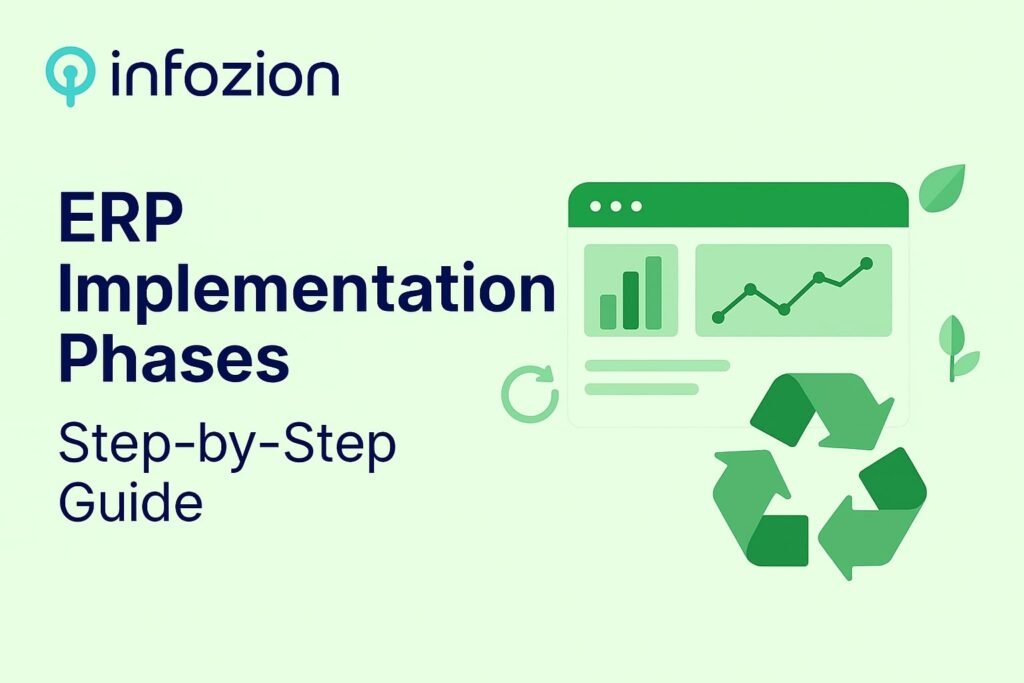In the modern business landscape, organizations must streamline operations, centralize data, and make faster, smarter decisions. Enterprise Resource Planning (ERP) systems enable companies to achieve these objectives by integrating critical business functions—finance, HR, inventory, and customer service—into a single, cohesive platform.
However, deploying an ERP system is more than just installing software. It is a strategic transformation that demands careful planning, execution, and monitoring. Understanding and following structured ERP Implementation Phases is key to ensuring a smooth transition and maximizing ROI. This article provides a comprehensive, phase-by-phase blueprint to guide businesses through the ERP implementation journey.
Why ERP Implementation Matters
ERP systems are designed to unify fragmented processes and provide real-time insights. Without a structured approach, ERP projects risk delays, cost overruns, and low adoption. The success of ERP implementation depends on following a clear roadmap that defines timelines, responsibilities, and deliverables.
By adhering to ERP Implementation Phases, businesses can systematically address challenges, align stakeholders, and achieve measurable outcomes.
Phase 1: Planning and Discovery
The first phase is all about setting a solid foundation. Planning ensures clarity in goals, scope, and resource allocation.
Key Activities
-
Define business objectives: Identify specific issues the ERP system should solve.
-
Assemble the project team: Include representatives from all key departments to ensure collaboration.
-
Assess current processes: Document workflows to identify inefficiencies and improvement areas.
-
Develop a project plan: Set timelines, budget, and milestones.
Milestones
-
Project charter approval
-
Stakeholder alignment
-
Initial business process mapping completed
Deliverables
-
Project plan and scope document
-
Communication and stakeholder engagement plan
-
Risk assessment report
Pro Tip: Clear communication during this stage ensures executive buy-in and sets the stage for successful change management.
Phase 2: ERP Selection and Vendor Evaluation
Selecting the right ERP system is a critical decision. Not all ERP solutions are created equal, and the choice can significantly impact long-term success.
Key Activities
-
Requirements gathering: Collect functional and technical needs from each department.
-
Vendor research: Evaluate potential ERP vendors based on features, scalability, and support.
-
Demo sessions and proof of concept: Assess usability and compatibility.
-
Request for Proposal (RFP) and evaluation: Analyze vendor proposals to select the best fit.
Milestones
-
Requirements documentation completed
-
Shortlist of vendors finalized
-
ERP solution selected
Deliverables
-
Vendor evaluation matrix
-
ERP selection report
-
Signed vendor contract
Proper evaluation at this stage ensures that the ERP system aligns with both current operations and future growth plans.
Phase 3: System Design and Blueprinting
Once the ERP solution is chosen, the focus shifts to designing the system to match business processes. Blueprinting is about translating business requirements into ERP configurations.
Key Activities
-
Process mapping: Align current workflows with ERP capabilities.
-
Configuration planning: Decide which modules and features will be customized.
-
Data architecture design: Determine how data will be structured and stored.
-
Change management strategy: Plan for user training and adoption.
Milestones
-
Completion of system design documents
-
Configuration plan approval
-
Change management plan finalized
Deliverables
-
ERP blueprint documentation
-
Module configuration plan
-
Detailed training and change management strategy
Minimizing unnecessary customizations during this phase reduces complexity and future upgrade challenges.
Phase 4: Data Migration and Cleansing
Data is the lifeblood of any ERP system. Clean, accurate, and structured data ensures smooth operations and reliable reporting.
Key Activities
-
Data cleansing: Remove duplicate, outdated, or incorrect records.
-
Data mapping: Align legacy system data with ERP fields.
-
Pilot migration: Test a sample dataset to validate accuracy.
-
Full migration: Transfer complete datasets into the ERP system.
Milestones
-
Data validation completed
-
Test migration successfully executed
-
Full migration sign-off
Deliverables
-
Data migration plan
-
Mapping and validation documentation
-
Migrated datasets ready for testing
Accurate data migration reduces errors and builds trust in the ERP system from day one.
Phase 5: Testing and Quality Assurance
Testing ensures that the ERP system works as intended and meets business requirements. It is a crucial step before going live.
Key Activities
-
Unit testing: Validate individual modules.
-
Integration testing: Confirm smooth interaction between modules and other systems.
-
User Acceptance Testing (UAT): Real users simulate daily activities to confirm usability.
-
Issue resolution: Identify and fix bugs before deployment.
Milestones
-
Successful unit and integration tests
-
UAT completed with approval
-
All critical issues resolved
Deliverables
-
Test plans and scripts
-
Test result reports
-
Approved UAT documentation
Testing across all modules ensures operational reliability and reduces post-launch disruptions.
Phase 6: Training and Change Management
ERP success depends on user adoption. Proper training and change management prepare employees to embrace the new system.
Key Activities
-
Role-specific training: Hands-on sessions tailored to different departments.
-
Documentation: Manuals, quick guides, and FAQs for ongoing reference.
-
Support setup: Establish help desks and ERP champions to assist users.
-
Communication of benefits: Emphasize how the ERP system improves efficiency and productivity.
Milestones
-
Completion of all training programs
-
User readiness assessment
-
Support channels operational
Deliverables
-
Training materials and attendance logs
-
Communication plan for ERP adoption
-
Support and escalation protocols
A strong focus on training ensures smooth transition and higher user satisfaction.
Phase 7: Go-Live and Post-Implementation Support
The final stage is system deployment and continuous improvement. This is where the ERP system begins delivering real business value.
Key Activities
-
Go-live deployment: Execute the chosen deployment strategy (big-bang, phased, or parallel).
-
System monitoring: Track performance, user adoption, and operational efficiency.
-
Post-implementation support: Provide ongoing helpdesk support and troubleshooting.
-
Continuous improvement: Gather feedback and optimize processes and configurations.
Milestones
-
Successful go-live execution
-
Post-launch support team operational
-
Performance and KPI review completed
Deliverables
-
Go-live checklist and report
-
Support and maintenance plan
-
Continuous improvement roadmap
Ongoing support ensures that the ERP system continues to deliver value and adapts to changing business needs.
Conclusion
The ERP implementation journey is a structured process that transforms how organizations operate. By following the ERP Implementation Phases—from planning and selection to design, data migration, testing, training, and post-launch support—businesses can mitigate risks, enhance user adoption, and achieve measurable results.
A phase-by-phase approach ensures that milestones are met, deliverables are completed, and stakeholders remain engaged throughout the journey. With careful planning, execution, and support, ERP implementation becomes more than a software project—it becomes a catalyst for organizational growth and operational excellence.







